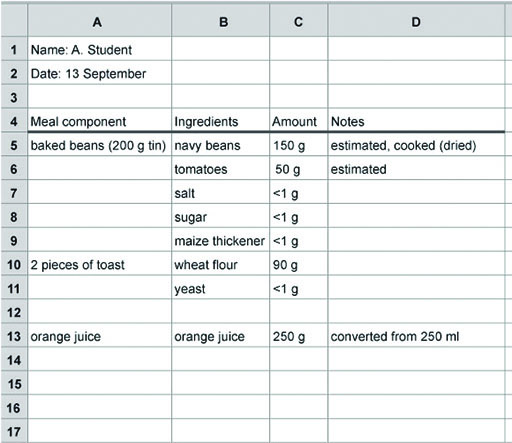3 ‘You are what you eat’
To consider dietary sustainability it is first important to think about what you eat. One of the techniques used to record dietary intake is a food diary. This involves noting down what someone has eaten over a given period, with an accompanying estimate of portion size. Activity 3 explains this process further. You will use the data you collect here in Activity 5 also.
Activity 3 Making a food diary
Produce a food diary entry to record all the food and drink that you, or a friend or relative, have eaten during a single day. It may be useful to record this in a spreadsheet like in Figure 2.
Now estimate the size (mass) of each item consumed with the aid of the following resource: Your balanced diet: Get portion wise! [Tip: hold Ctrl and click a link to open it in a new tab. (Hide tip)]
Add the portion size data to your diary, as per Figure 2. Remember to separate out the component elements of what you ate, as far as possible, where a single foodstuff or meal contains multiple ingredients.
It is important to note that there is no standard view on portion size, and the BNF (2019) table is a (UK-based) guide to what represents a portion of each foodstuff. You can find additional sources used for the quantification of portion size on the internet if the table does not list the foods you have eaten. If this is the case, make sure that you cite the source(s) used in the estimations of portion size alongside your food diary so it is clear where your information has come from. Likewise, for single-ingredient foods like a piece of fruit, you could weigh the item before eating it, and record this as the size of that portion.
When you have completed your food diary entry, reflect on the following questions:
- How straightforward was it to match what you recorded in your diary to the categories in the table?
- How easy was it to estimate portion size of the food eaten?
Nex you will look at how much variety there is on your dinner plate.

